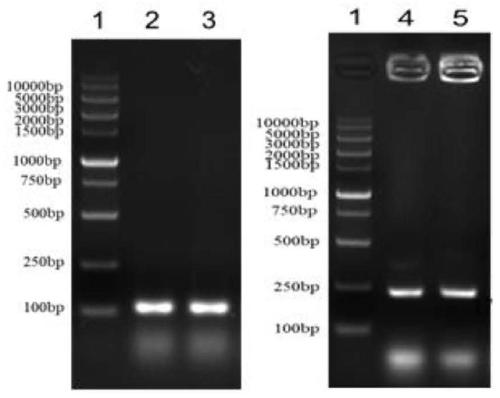Lactobacillus plantarum for expressing mouse antibacterial peptide gene
A Lactobacillus plantarum and gene technology, applied in the field of genetic engineering, can solve the problems of inability to achieve intestinal targeted delivery and reduction of digestive tract enzymes, and achieve the effects of promoting healthy intestinal development, strong cellular immune response, and good industrial prospects.
- Summary
- Abstract
- Description
- Claims
- Application Information
AI Technical Summary
Problems solved by technology
Method used
Image
Examples
Embodiment 1
[0059] Embodiment 1 Construction of recombinant plasmid pMG36e-CRAMP
[0060] (1) Codon preference optimization and synthesis of the gene sequence: According to the sequence of the target gene CRAMP gene and the characteristics of the expression vector pMG36e, the 108bp codon-optimized sequence of the CRAMP gene was sent to the company for synthesis by artificial synthesis. Xbal-CRAMP-F is an upstream primer containing the restriction site Xbal (TCTAGA) fused with pMG36e and the initial sequence of the 5' end of the signal peptide CRAMP, and CRAMP-Sph1-R is an upstream primer with a restriction site Sph1 (GCATGC ) CRAMP gene reverse primer. The optimally synthesized CRAMP sequence is shown in SEQ ID NO: 1; the optimally synthesized Xbal-CRAMP-F and CRAMP-Sph1-R primer sequences are shown in SEQ ID NO: 5-6, respectively.
[0061] (2) PCR amplification of CRAMP gene fragments: using the optimized synthesized CRAMP gene as a template, add high-fidelity DNA polymerase KOD-Plus-(1...
Embodiment 2
[0063] Example 2 Construction of recombinant plasmid pNZ8148-CRAMP
[0064](1) Codon preference optimization and synthesis of the gene sequence: According to the sequence of the target gene CRAMP gene and the characteristics of the expression vector pMG36e, the 108bp codon-optimized sequence of the CRAMP gene was sent to the company for synthesis by artificial synthesis. Sph1-CRAMP-F is an upstream primer containing the restriction site Sph1 (GCATGC) fused with pMG36e and the initial sequence of the 5' end of the signal peptide CRAMP, and CRAMP-Xbal-R is an upstream primer with restriction site Xbal (TCTAGA ) CRAMP gene reverse primer. The optimized and synthesized CRAMP sequence is shown in SEQ ID NO: 1; the optimized and synthesized Sph1-CRAMP-F and CRAMP-Xbal-R primer sequences are shown in SEQ ID NO: 7-8 respectively.
[0065] (2) PCR amplification of CRAMP gene fragments: using the optimized synthesized CRAMP gene as a template, add high-fidelity DNA polymerase KOD-Plus-...
Embodiment 3
[0067] Example 3 Construction of recombinant plasmid pMG36e-Usp45-Linker-CRAMP
[0068] (1) Codon preference optimization and synthesis of the gene sequence: According to the sequence of the target gene CRAMP gene and the characteristics of the expression vector pMG36e, and the signal peptide sequence Usp45 added for the purpose of efficient secretion and expression, artificially synthesized The 243bp codon-optimized sequence of the Usp45-Linker-CRAMP gene was sent to the company for synthesis. Xbal-Usp45-Linker-CRAMP-F is an upstream primer containing the first sequence of the 5' end of the restriction site Xbal fused with pMG36e and the signal peptide Usp45-Linker-CRAMP, and Usp45-Linker-CRAMP-Sph1-R is Signal peptide Usp45-Linker-CRAMP gene reverse primer. At the same time, primers pNZ1 and pNZ2 for PCR detection and sequencing of recombinant plasmids were also designed, which were designed based on the region of about 70-90 bp upstream and downstream of the MCS of pMG36e ...
PUM
 Login to View More
Login to View More Abstract
Description
Claims
Application Information
 Login to View More
Login to View More - R&D Engineer
- R&D Manager
- IP Professional
- Industry Leading Data Capabilities
- Powerful AI technology
- Patent DNA Extraction
Browse by: Latest US Patents, China's latest patents, Technical Efficacy Thesaurus, Application Domain, Technology Topic, Popular Technical Reports.
© 2024 PatSnap. All rights reserved.Legal|Privacy policy|Modern Slavery Act Transparency Statement|Sitemap|About US| Contact US: help@patsnap.com










